Organisational Behaviour Report: Tesco's Culture and Performance
VerifiedAdded on 2020/10/22
|12
|3393
|351
Report
AI Summary
This report analyzes organisational behaviour within Tesco, a major UK supermarket chain. It explores how organisational culture, power dynamics, and political influences affect individual and team behaviour, impacting overall performance. The report examines Handy's typology of organisational culture, including power, role, and task cultures, and discusses the impact of managerial power and political behaviour. It evaluates content and process theories of motivation, such as Maslow's hierarchy of needs and process theories, and how they can be applied to achieve organisational goals. Furthermore, the report identifies factors that contribute to effective teamwork, including different team types and Tuckman's model of team development. The study aims to provide insights into Tesco's management strategies and their effects on employee engagement and productivity. This report offers a comprehensive overview of organisational behaviour principles and their practical application within a real-world business context.
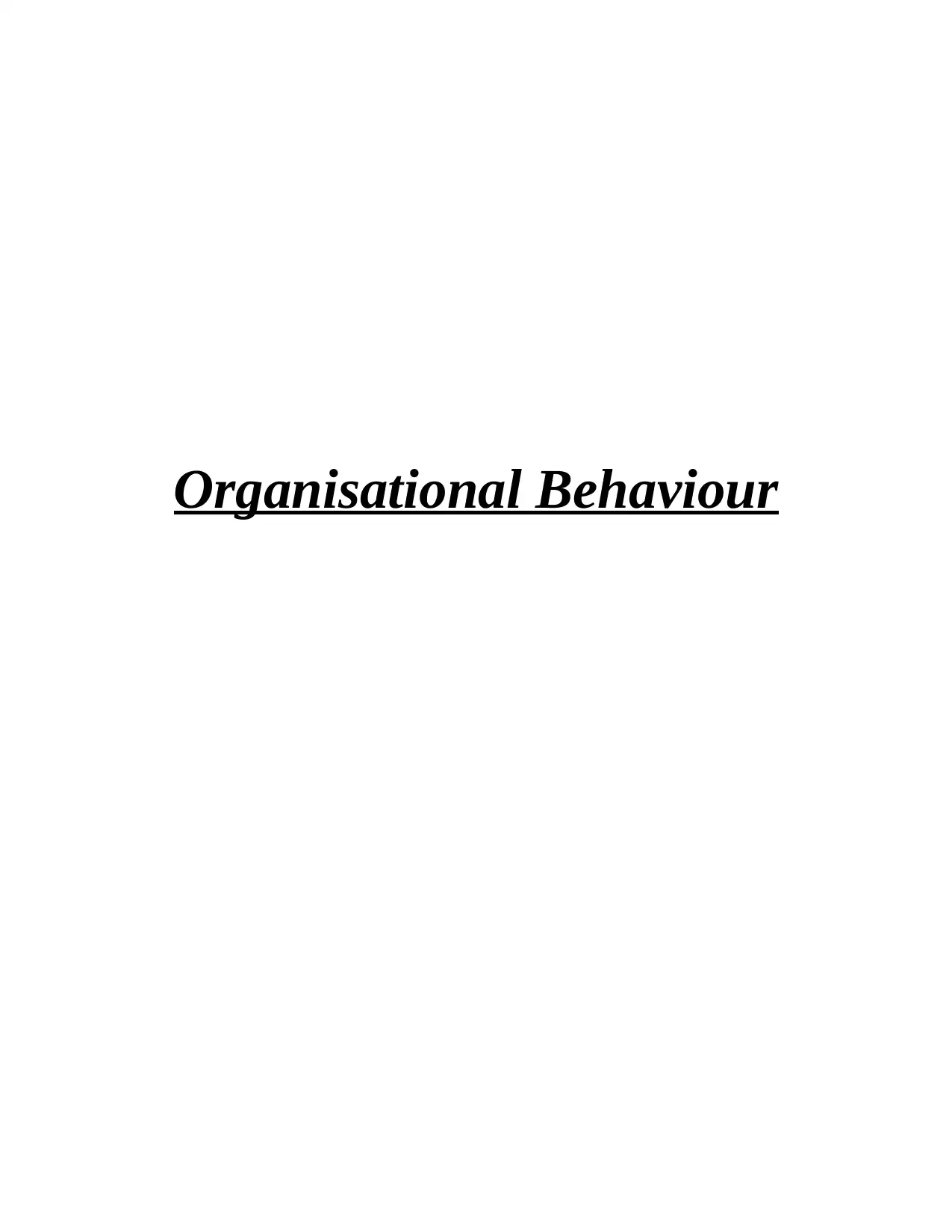
Organisational Behaviour
Paraphrase This Document
Need a fresh take? Get an instant paraphrase of this document with our AI Paraphraser
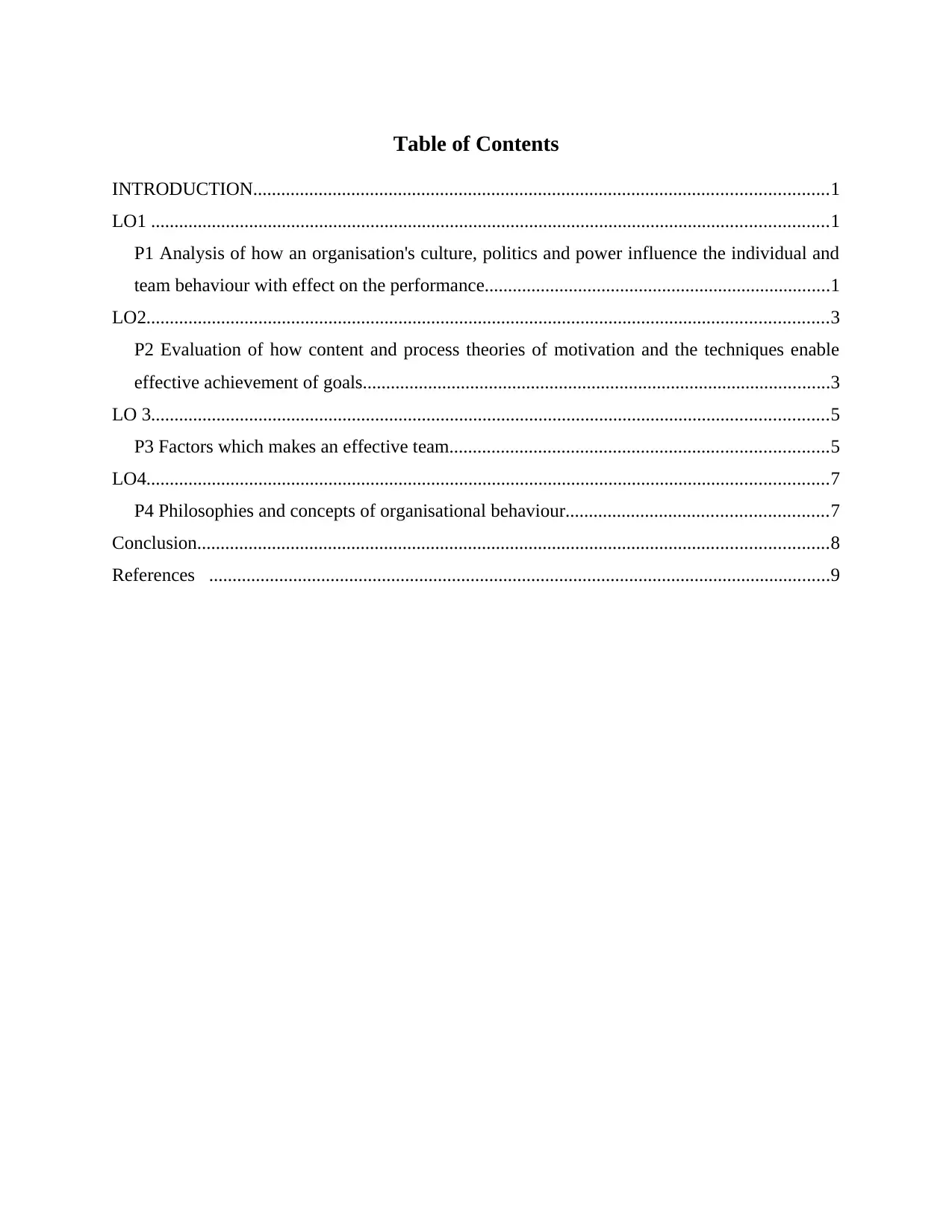
Table of Contents
INTRODUCTION...........................................................................................................................1
LO1 .................................................................................................................................................1
P1 Analysis of how an organisation's culture, politics and power influence the individual and
team behaviour with effect on the performance..........................................................................1
LO2..................................................................................................................................................3
P2 Evaluation of how content and process theories of motivation and the techniques enable
effective achievement of goals....................................................................................................3
LO 3.................................................................................................................................................5
P3 Factors which makes an effective team.................................................................................5
LO4..................................................................................................................................................7
P4 Philosophies and concepts of organisational behaviour........................................................7
Conclusion.......................................................................................................................................8
References .....................................................................................................................................9
INTRODUCTION...........................................................................................................................1
LO1 .................................................................................................................................................1
P1 Analysis of how an organisation's culture, politics and power influence the individual and
team behaviour with effect on the performance..........................................................................1
LO2..................................................................................................................................................3
P2 Evaluation of how content and process theories of motivation and the techniques enable
effective achievement of goals....................................................................................................3
LO 3.................................................................................................................................................5
P3 Factors which makes an effective team.................................................................................5
LO4..................................................................................................................................................7
P4 Philosophies and concepts of organisational behaviour........................................................7
Conclusion.......................................................................................................................................8
References .....................................................................................................................................9

⊘ This is a preview!⊘
Do you want full access?
Subscribe today to unlock all pages.

Trusted by 1+ million students worldwide
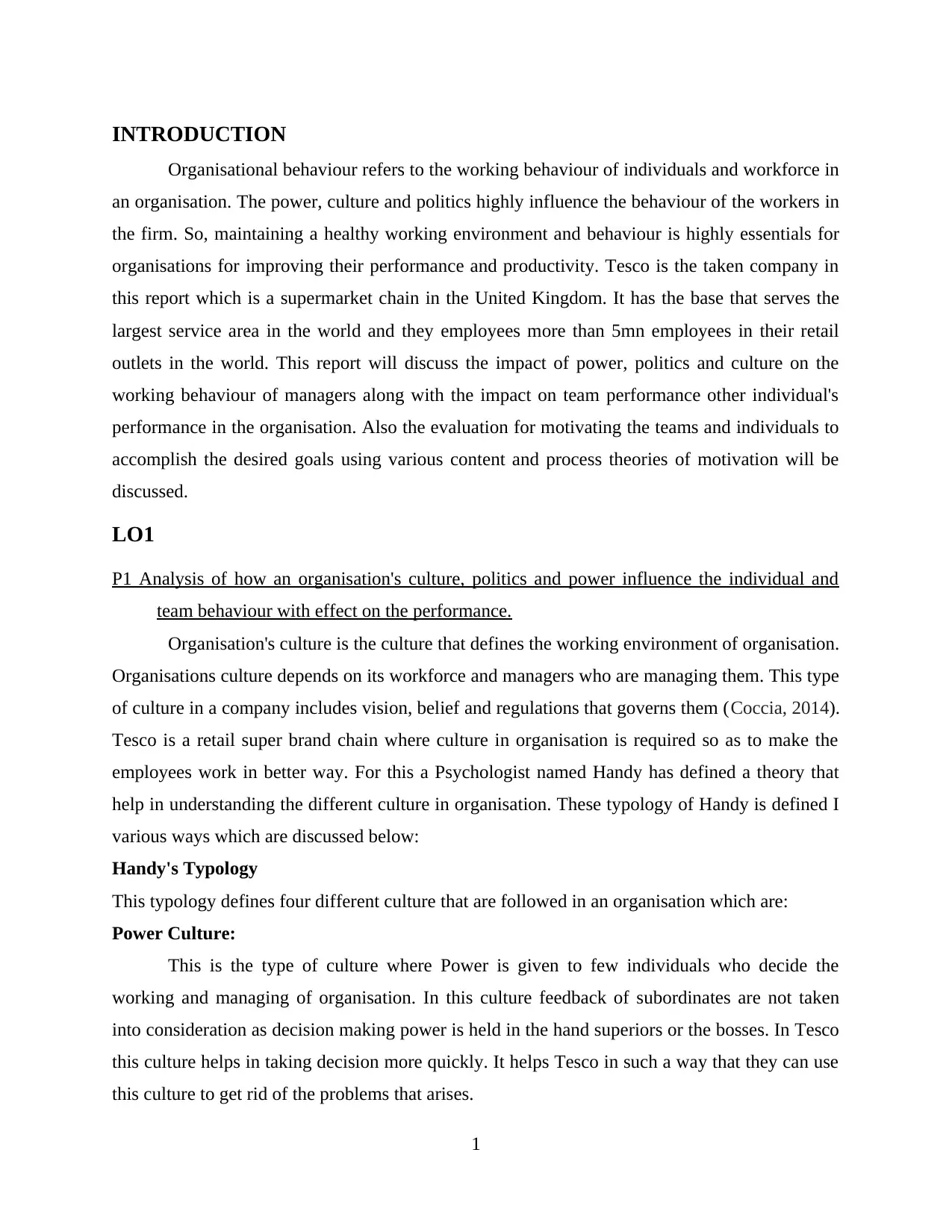
INTRODUCTION
Organisational behaviour refers to the working behaviour of individuals and workforce in
an organisation. The power, culture and politics highly influence the behaviour of the workers in
the firm. So, maintaining a healthy working environment and behaviour is highly essentials for
organisations for improving their performance and productivity. Tesco is the taken company in
this report which is a supermarket chain in the United Kingdom. It has the base that serves the
largest service area in the world and they employees more than 5mn employees in their retail
outlets in the world. This report will discuss the impact of power, politics and culture on the
working behaviour of managers along with the impact on team performance other individual's
performance in the organisation. Also the evaluation for motivating the teams and individuals to
accomplish the desired goals using various content and process theories of motivation will be
discussed.
LO1
P1 Analysis of how an organisation's culture, politics and power influence the individual and
team behaviour with effect on the performance.
Organisation's culture is the culture that defines the working environment of organisation.
Organisations culture depends on its workforce and managers who are managing them. This type
of culture in a company includes vision, belief and regulations that governs them (Coccia, 2014).
Tesco is a retail super brand chain where culture in organisation is required so as to make the
employees work in better way. For this a Psychologist named Handy has defined a theory that
help in understanding the different culture in organisation. These typology of Handy is defined I
various ways which are discussed below:
Handy's Typology
This typology defines four different culture that are followed in an organisation which are:
Power Culture:
This is the type of culture where Power is given to few individuals who decide the
working and managing of organisation. In this culture feedback of subordinates are not taken
into consideration as decision making power is held in the hand superiors or the bosses. In Tesco
this culture helps in taking decision more quickly. It helps Tesco in such a way that they can use
this culture to get rid of the problems that arises.
1
Organisational behaviour refers to the working behaviour of individuals and workforce in
an organisation. The power, culture and politics highly influence the behaviour of the workers in
the firm. So, maintaining a healthy working environment and behaviour is highly essentials for
organisations for improving their performance and productivity. Tesco is the taken company in
this report which is a supermarket chain in the United Kingdom. It has the base that serves the
largest service area in the world and they employees more than 5mn employees in their retail
outlets in the world. This report will discuss the impact of power, politics and culture on the
working behaviour of managers along with the impact on team performance other individual's
performance in the organisation. Also the evaluation for motivating the teams and individuals to
accomplish the desired goals using various content and process theories of motivation will be
discussed.
LO1
P1 Analysis of how an organisation's culture, politics and power influence the individual and
team behaviour with effect on the performance.
Organisation's culture is the culture that defines the working environment of organisation.
Organisations culture depends on its workforce and managers who are managing them. This type
of culture in a company includes vision, belief and regulations that governs them (Coccia, 2014).
Tesco is a retail super brand chain where culture in organisation is required so as to make the
employees work in better way. For this a Psychologist named Handy has defined a theory that
help in understanding the different culture in organisation. These typology of Handy is defined I
various ways which are discussed below:
Handy's Typology
This typology defines four different culture that are followed in an organisation which are:
Power Culture:
This is the type of culture where Power is given to few individuals who decide the
working and managing of organisation. In this culture feedback of subordinates are not taken
into consideration as decision making power is held in the hand superiors or the bosses. In Tesco
this culture helps in taking decision more quickly. It helps Tesco in such a way that they can use
this culture to get rid of the problems that arises.
1
Paraphrase This Document
Need a fresh take? Get an instant paraphrase of this document with our AI Paraphraser
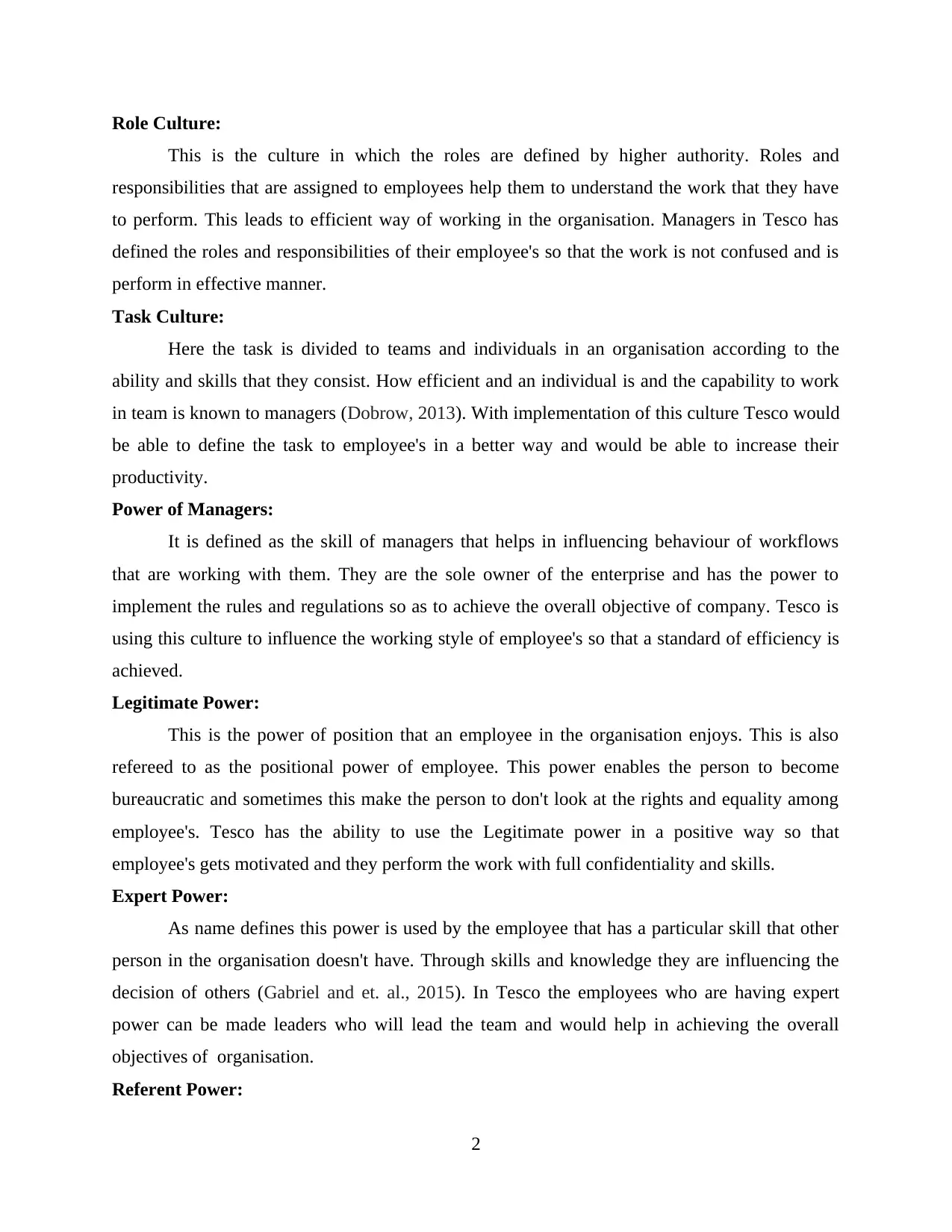
Role Culture:
This is the culture in which the roles are defined by higher authority. Roles and
responsibilities that are assigned to employees help them to understand the work that they have
to perform. This leads to efficient way of working in the organisation. Managers in Tesco has
defined the roles and responsibilities of their employee's so that the work is not confused and is
perform in effective manner.
Task Culture:
Here the task is divided to teams and individuals in an organisation according to the
ability and skills that they consist. How efficient and an individual is and the capability to work
in team is known to managers (Dobrow, 2013). With implementation of this culture Tesco would
be able to define the task to employee's in a better way and would be able to increase their
productivity.
Power of Managers:
It is defined as the skill of managers that helps in influencing behaviour of workflows
that are working with them. They are the sole owner of the enterprise and has the power to
implement the rules and regulations so as to achieve the overall objective of company. Tesco is
using this culture to influence the working style of employee's so that a standard of efficiency is
achieved.
Legitimate Power:
This is the power of position that an employee in the organisation enjoys. This is also
refereed to as the positional power of employee. This power enables the person to become
bureaucratic and sometimes this make the person to don't look at the rights and equality among
employee's. Tesco has the ability to use the Legitimate power in a positive way so that
employee's gets motivated and they perform the work with full confidentiality and skills.
Expert Power:
As name defines this power is used by the employee that has a particular skill that other
person in the organisation doesn't have. Through skills and knowledge they are influencing the
decision of others (Gabriel and et. al., 2015). In Tesco the employees who are having expert
power can be made leaders who will lead the team and would help in achieving the overall
objectives of organisation.
Referent Power:
2
This is the culture in which the roles are defined by higher authority. Roles and
responsibilities that are assigned to employees help them to understand the work that they have
to perform. This leads to efficient way of working in the organisation. Managers in Tesco has
defined the roles and responsibilities of their employee's so that the work is not confused and is
perform in effective manner.
Task Culture:
Here the task is divided to teams and individuals in an organisation according to the
ability and skills that they consist. How efficient and an individual is and the capability to work
in team is known to managers (Dobrow, 2013). With implementation of this culture Tesco would
be able to define the task to employee's in a better way and would be able to increase their
productivity.
Power of Managers:
It is defined as the skill of managers that helps in influencing behaviour of workflows
that are working with them. They are the sole owner of the enterprise and has the power to
implement the rules and regulations so as to achieve the overall objective of company. Tesco is
using this culture to influence the working style of employee's so that a standard of efficiency is
achieved.
Legitimate Power:
This is the power of position that an employee in the organisation enjoys. This is also
refereed to as the positional power of employee. This power enables the person to become
bureaucratic and sometimes this make the person to don't look at the rights and equality among
employee's. Tesco has the ability to use the Legitimate power in a positive way so that
employee's gets motivated and they perform the work with full confidentiality and skills.
Expert Power:
As name defines this power is used by the employee that has a particular skill that other
person in the organisation doesn't have. Through skills and knowledge they are influencing the
decision of others (Gabriel and et. al., 2015). In Tesco the employees who are having expert
power can be made leaders who will lead the team and would help in achieving the overall
objectives of organisation.
Referent Power:
2
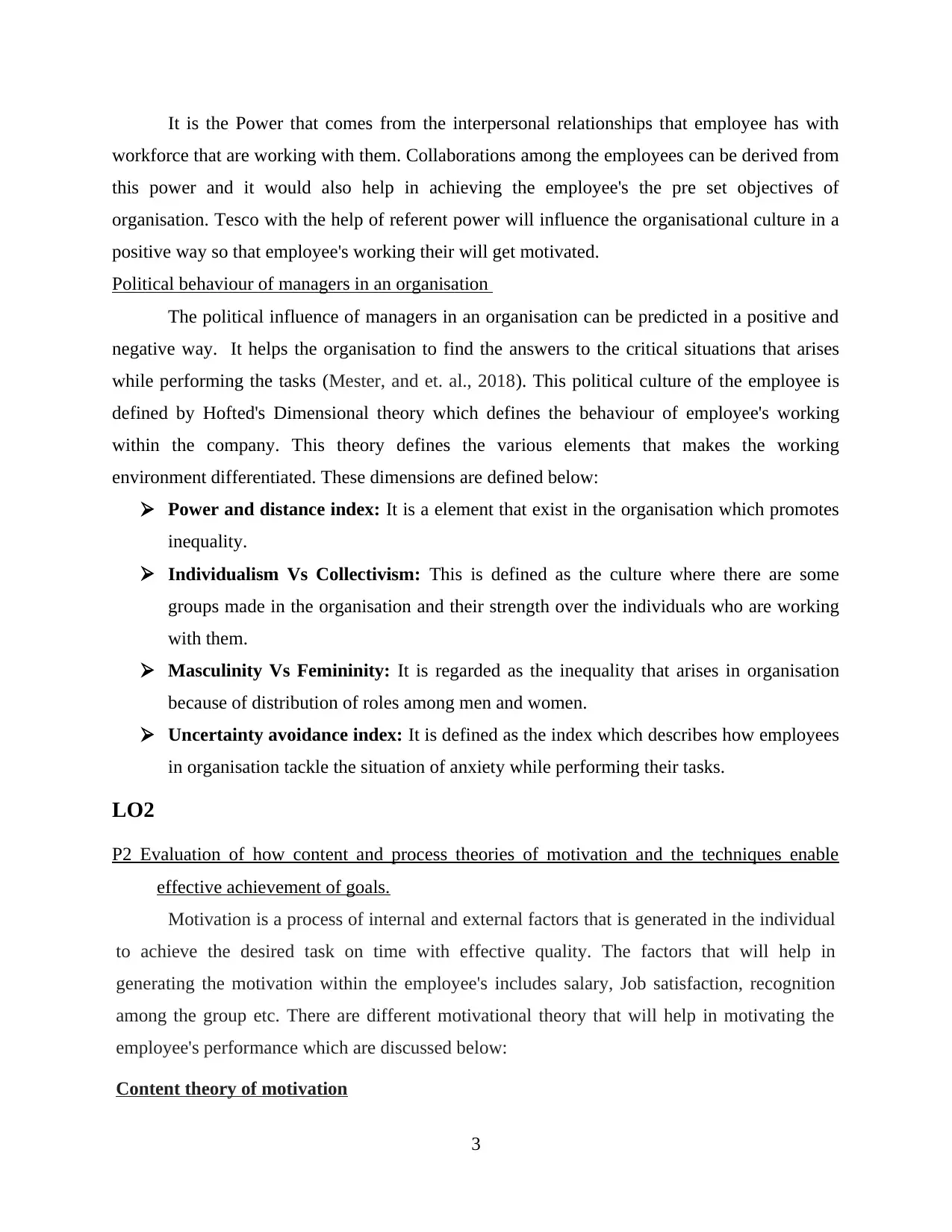
It is the Power that comes from the interpersonal relationships that employee has with
workforce that are working with them. Collaborations among the employees can be derived from
this power and it would also help in achieving the employee's the pre set objectives of
organisation. Tesco with the help of referent power will influence the organisational culture in a
positive way so that employee's working their will get motivated.
Political behaviour of managers in an organisation
The political influence of managers in an organisation can be predicted in a positive and
negative way. It helps the organisation to find the answers to the critical situations that arises
while performing the tasks (Mester, and et. al., 2018). This political culture of the employee is
defined by Hofted's Dimensional theory which defines the behaviour of employee's working
within the company. This theory defines the various elements that makes the working
environment differentiated. These dimensions are defined below:
Power and distance index: It is a element that exist in the organisation which promotes
inequality.
Individualism Vs Collectivism: This is defined as the culture where there are some
groups made in the organisation and their strength over the individuals who are working
with them.
Masculinity Vs Femininity: It is regarded as the inequality that arises in organisation
because of distribution of roles among men and women.
Uncertainty avoidance index: It is defined as the index which describes how employees
in organisation tackle the situation of anxiety while performing their tasks.
LO2
P2 Evaluation of how content and process theories of motivation and the techniques enable
effective achievement of goals.
Motivation is a process of internal and external factors that is generated in the individual
to achieve the desired task on time with effective quality. The factors that will help in
generating the motivation within the employee's includes salary, Job satisfaction, recognition
among the group etc. There are different motivational theory that will help in motivating the
employee's performance which are discussed below:
Content theory of motivation
3
workforce that are working with them. Collaborations among the employees can be derived from
this power and it would also help in achieving the employee's the pre set objectives of
organisation. Tesco with the help of referent power will influence the organisational culture in a
positive way so that employee's working their will get motivated.
Political behaviour of managers in an organisation
The political influence of managers in an organisation can be predicted in a positive and
negative way. It helps the organisation to find the answers to the critical situations that arises
while performing the tasks (Mester, and et. al., 2018). This political culture of the employee is
defined by Hofted's Dimensional theory which defines the behaviour of employee's working
within the company. This theory defines the various elements that makes the working
environment differentiated. These dimensions are defined below:
Power and distance index: It is a element that exist in the organisation which promotes
inequality.
Individualism Vs Collectivism: This is defined as the culture where there are some
groups made in the organisation and their strength over the individuals who are working
with them.
Masculinity Vs Femininity: It is regarded as the inequality that arises in organisation
because of distribution of roles among men and women.
Uncertainty avoidance index: It is defined as the index which describes how employees
in organisation tackle the situation of anxiety while performing their tasks.
LO2
P2 Evaluation of how content and process theories of motivation and the techniques enable
effective achievement of goals.
Motivation is a process of internal and external factors that is generated in the individual
to achieve the desired task on time with effective quality. The factors that will help in
generating the motivation within the employee's includes salary, Job satisfaction, recognition
among the group etc. There are different motivational theory that will help in motivating the
employee's performance which are discussed below:
Content theory of motivation
3
⊘ This is a preview!⊘
Do you want full access?
Subscribe today to unlock all pages.

Trusted by 1+ million students worldwide
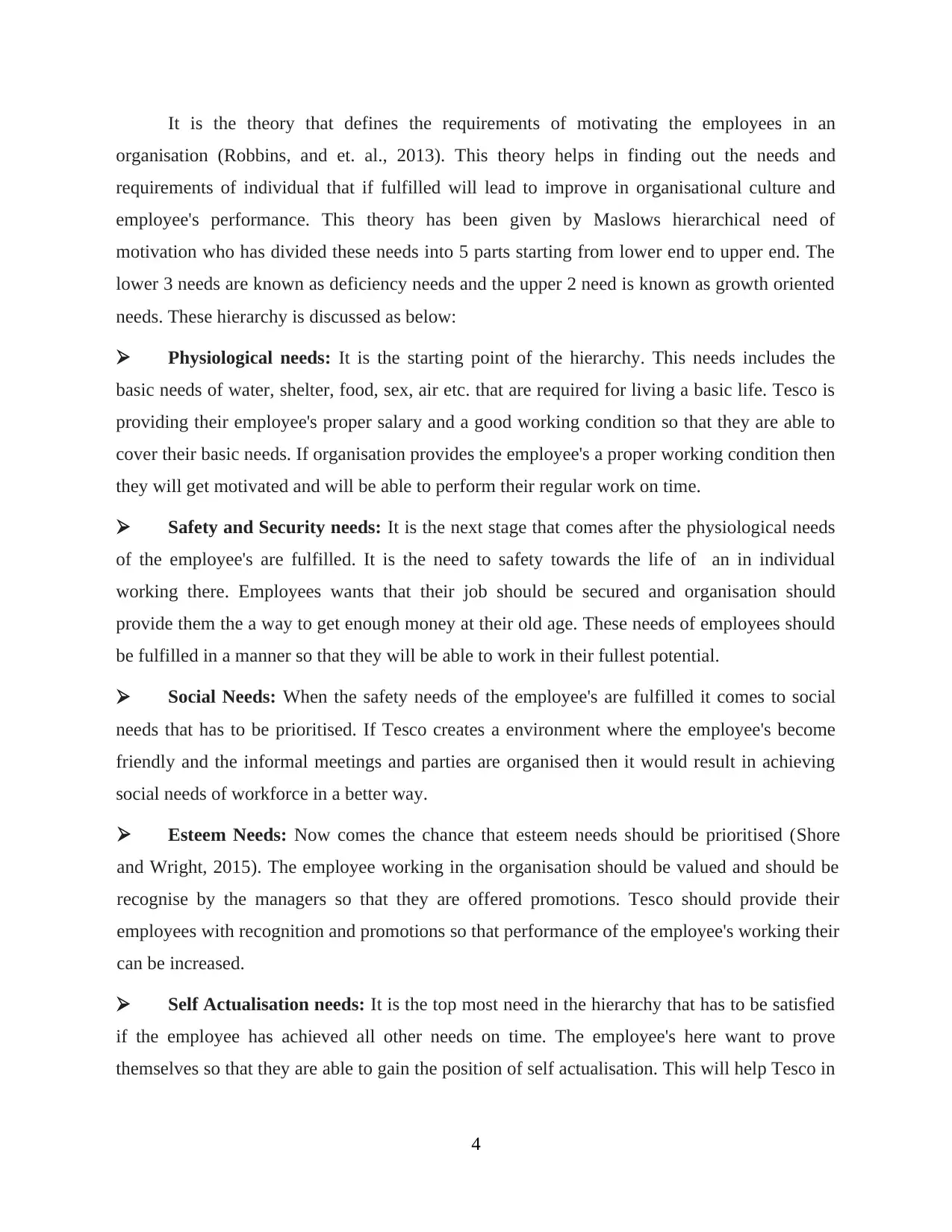
It is the theory that defines the requirements of motivating the employees in an
organisation (Robbins, and et. al., 2013). This theory helps in finding out the needs and
requirements of individual that if fulfilled will lead to improve in organisational culture and
employee's performance. This theory has been given by Maslows hierarchical need of
motivation who has divided these needs into 5 parts starting from lower end to upper end. The
lower 3 needs are known as deficiency needs and the upper 2 need is known as growth oriented
needs. These hierarchy is discussed as below:
Physiological needs: It is the starting point of the hierarchy. This needs includes the
basic needs of water, shelter, food, sex, air etc. that are required for living a basic life. Tesco is
providing their employee's proper salary and a good working condition so that they are able to
cover their basic needs. If organisation provides the employee's a proper working condition then
they will get motivated and will be able to perform their regular work on time.
Safety and Security needs: It is the next stage that comes after the physiological needs
of the employee's are fulfilled. It is the need to safety towards the life of an in individual
working there. Employees wants that their job should be secured and organisation should
provide them the a way to get enough money at their old age. These needs of employees should
be fulfilled in a manner so that they will be able to work in their fullest potential.
Social Needs: When the safety needs of the employee's are fulfilled it comes to social
needs that has to be prioritised. If Tesco creates a environment where the employee's become
friendly and the informal meetings and parties are organised then it would result in achieving
social needs of workforce in a better way.
Esteem Needs: Now comes the chance that esteem needs should be prioritised (Shore
and Wright, 2015). The employee working in the organisation should be valued and should be
recognise by the managers so that they are offered promotions. Tesco should provide their
employees with recognition and promotions so that performance of the employee's working their
can be increased.
Self Actualisation needs: It is the top most need in the hierarchy that has to be satisfied
if the employee has achieved all other needs on time. The employee's here want to prove
themselves so that they are able to gain the position of self actualisation. This will help Tesco in
4
organisation (Robbins, and et. al., 2013). This theory helps in finding out the needs and
requirements of individual that if fulfilled will lead to improve in organisational culture and
employee's performance. This theory has been given by Maslows hierarchical need of
motivation who has divided these needs into 5 parts starting from lower end to upper end. The
lower 3 needs are known as deficiency needs and the upper 2 need is known as growth oriented
needs. These hierarchy is discussed as below:
Physiological needs: It is the starting point of the hierarchy. This needs includes the
basic needs of water, shelter, food, sex, air etc. that are required for living a basic life. Tesco is
providing their employee's proper salary and a good working condition so that they are able to
cover their basic needs. If organisation provides the employee's a proper working condition then
they will get motivated and will be able to perform their regular work on time.
Safety and Security needs: It is the next stage that comes after the physiological needs
of the employee's are fulfilled. It is the need to safety towards the life of an in individual
working there. Employees wants that their job should be secured and organisation should
provide them the a way to get enough money at their old age. These needs of employees should
be fulfilled in a manner so that they will be able to work in their fullest potential.
Social Needs: When the safety needs of the employee's are fulfilled it comes to social
needs that has to be prioritised. If Tesco creates a environment where the employee's become
friendly and the informal meetings and parties are organised then it would result in achieving
social needs of workforce in a better way.
Esteem Needs: Now comes the chance that esteem needs should be prioritised (Shore
and Wright, 2015). The employee working in the organisation should be valued and should be
recognise by the managers so that they are offered promotions. Tesco should provide their
employees with recognition and promotions so that performance of the employee's working their
can be increased.
Self Actualisation needs: It is the top most need in the hierarchy that has to be satisfied
if the employee has achieved all other needs on time. The employee's here want to prove
themselves so that they are able to gain the position of self actualisation. This will help Tesco in
4
Paraphrase This Document
Need a fresh take? Get an instant paraphrase of this document with our AI Paraphraser
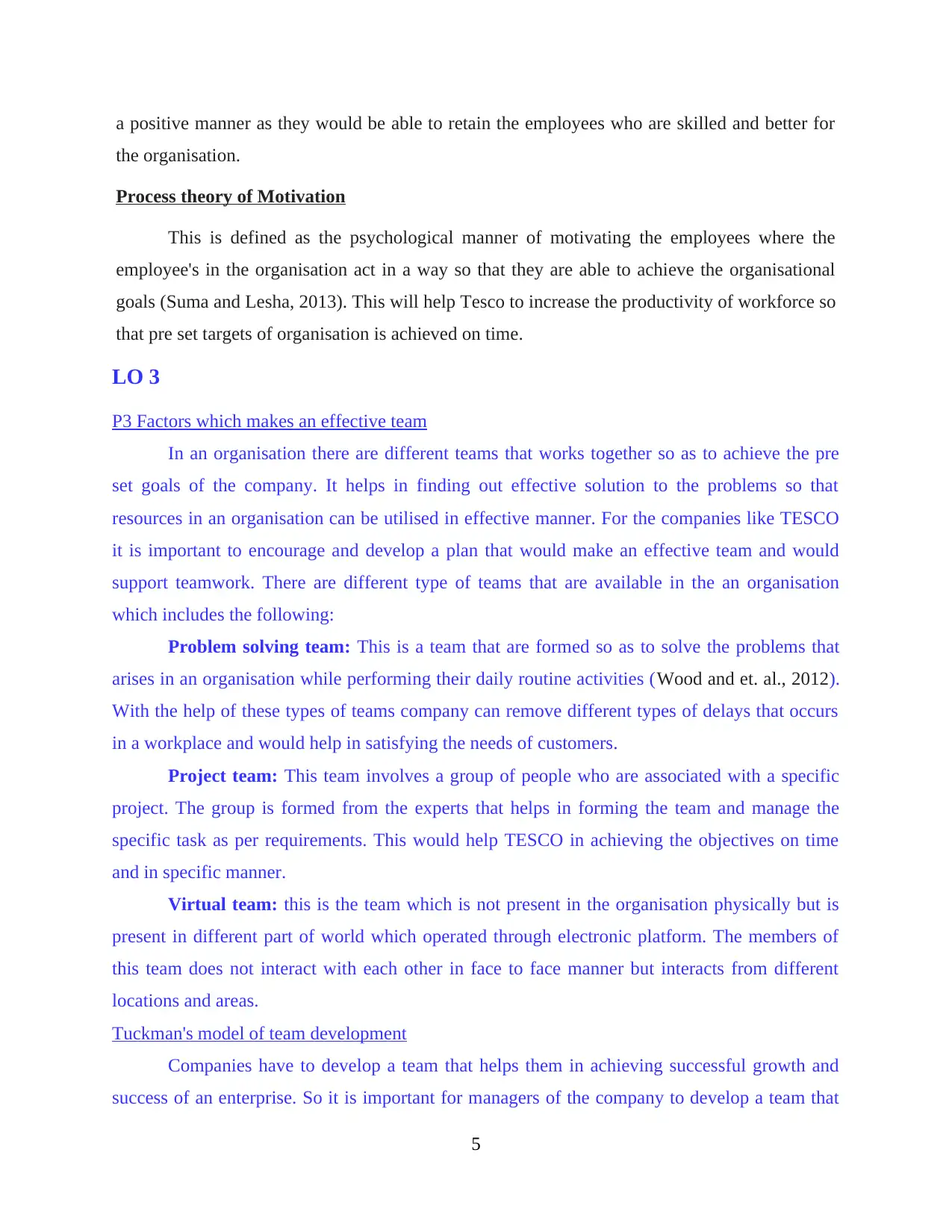
a positive manner as they would be able to retain the employees who are skilled and better for
the organisation.
Process theory of Motivation
This is defined as the psychological manner of motivating the employees where the
employee's in the organisation act in a way so that they are able to achieve the organisational
goals (Suma and Lesha, 2013). This will help Tesco to increase the productivity of workforce so
that pre set targets of organisation is achieved on time.
LO 3
P3 Factors which makes an effective team
In an organisation there are different teams that works together so as to achieve the pre
set goals of the company. It helps in finding out effective solution to the problems so that
resources in an organisation can be utilised in effective manner. For the companies like TESCO
it is important to encourage and develop a plan that would make an effective team and would
support teamwork. There are different type of teams that are available in the an organisation
which includes the following:
Problem solving team: This is a team that are formed so as to solve the problems that
arises in an organisation while performing their daily routine activities (Wood and et. al., 2012).
With the help of these types of teams company can remove different types of delays that occurs
in a workplace and would help in satisfying the needs of customers.
Project team: This team involves a group of people who are associated with a specific
project. The group is formed from the experts that helps in forming the team and manage the
specific task as per requirements. This would help TESCO in achieving the objectives on time
and in specific manner.
Virtual team: this is the team which is not present in the organisation physically but is
present in different part of world which operated through electronic platform. The members of
this team does not interact with each other in face to face manner but interacts from different
locations and areas.
Tuckman's model of team development
Companies have to develop a team that helps them in achieving successful growth and
success of an enterprise. So it is important for managers of the company to develop a team that
5
the organisation.
Process theory of Motivation
This is defined as the psychological manner of motivating the employees where the
employee's in the organisation act in a way so that they are able to achieve the organisational
goals (Suma and Lesha, 2013). This will help Tesco to increase the productivity of workforce so
that pre set targets of organisation is achieved on time.
LO 3
P3 Factors which makes an effective team
In an organisation there are different teams that works together so as to achieve the pre
set goals of the company. It helps in finding out effective solution to the problems so that
resources in an organisation can be utilised in effective manner. For the companies like TESCO
it is important to encourage and develop a plan that would make an effective team and would
support teamwork. There are different type of teams that are available in the an organisation
which includes the following:
Problem solving team: This is a team that are formed so as to solve the problems that
arises in an organisation while performing their daily routine activities (Wood and et. al., 2012).
With the help of these types of teams company can remove different types of delays that occurs
in a workplace and would help in satisfying the needs of customers.
Project team: This team involves a group of people who are associated with a specific
project. The group is formed from the experts that helps in forming the team and manage the
specific task as per requirements. This would help TESCO in achieving the objectives on time
and in specific manner.
Virtual team: this is the team which is not present in the organisation physically but is
present in different part of world which operated through electronic platform. The members of
this team does not interact with each other in face to face manner but interacts from different
locations and areas.
Tuckman's model of team development
Companies have to develop a team that helps them in achieving successful growth and
success of an enterprise. So it is important for managers of the company to develop a team that
5
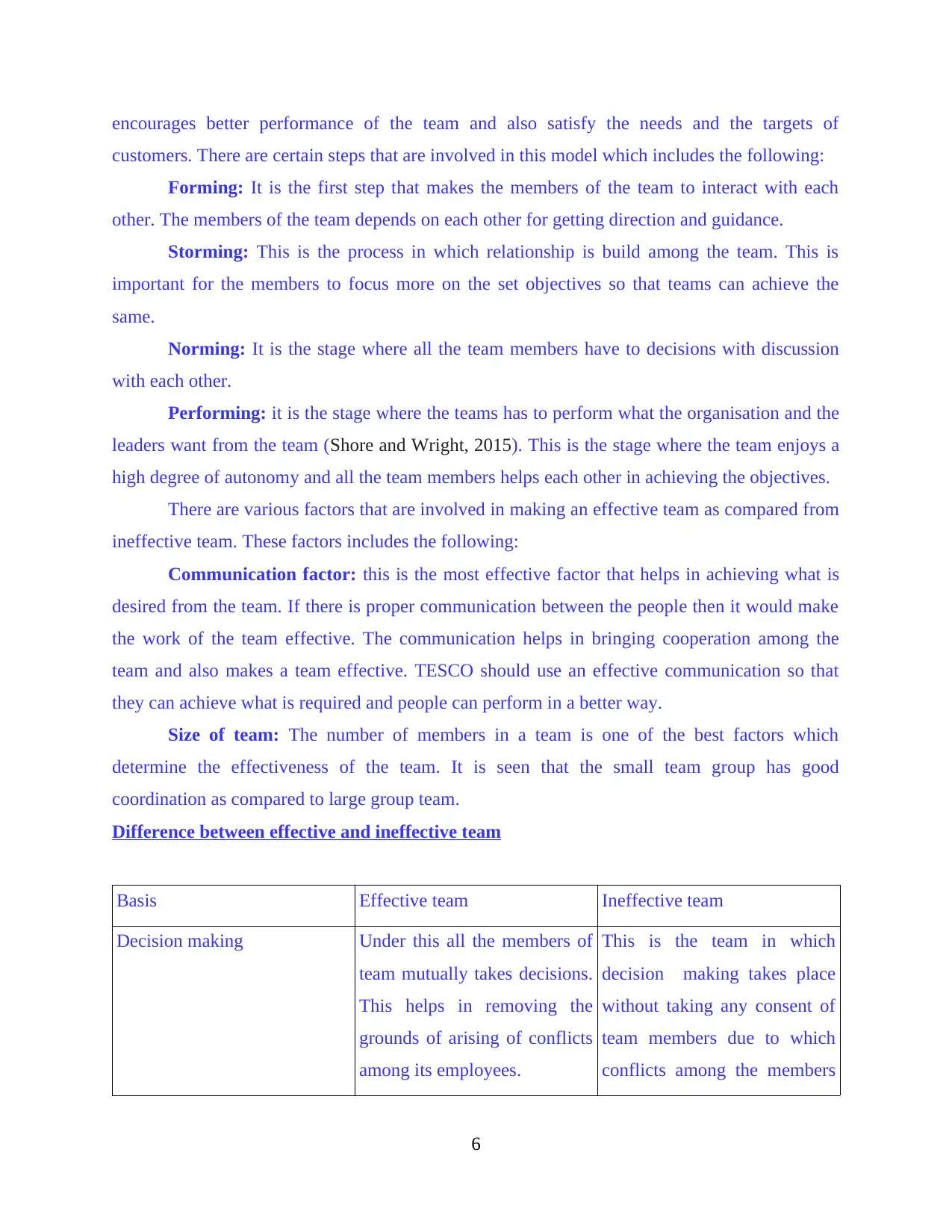
encourages better performance of the team and also satisfy the needs and the targets of
customers. There are certain steps that are involved in this model which includes the following:
Forming: It is the first step that makes the members of the team to interact with each
other. The members of the team depends on each other for getting direction and guidance.
Storming: This is the process in which relationship is build among the team. This is
important for the members to focus more on the set objectives so that teams can achieve the
same.
Norming: It is the stage where all the team members have to decisions with discussion
with each other.
Performing: it is the stage where the teams has to perform what the organisation and the
leaders want from the team (Shore and Wright, 2015). This is the stage where the team enjoys a
high degree of autonomy and all the team members helps each other in achieving the objectives.
There are various factors that are involved in making an effective team as compared from
ineffective team. These factors includes the following:
Communication factor: this is the most effective factor that helps in achieving what is
desired from the team. If there is proper communication between the people then it would make
the work of the team effective. The communication helps in bringing cooperation among the
team and also makes a team effective. TESCO should use an effective communication so that
they can achieve what is required and people can perform in a better way.
Size of team: The number of members in a team is one of the best factors which
determine the effectiveness of the team. It is seen that the small team group has good
coordination as compared to large group team.
Difference between effective and ineffective team
Basis Effective team Ineffective team
Decision making Under this all the members of
team mutually takes decisions.
This helps in removing the
grounds of arising of conflicts
among its employees.
This is the team in which
decision making takes place
without taking any consent of
team members due to which
conflicts among the members
6
customers. There are certain steps that are involved in this model which includes the following:
Forming: It is the first step that makes the members of the team to interact with each
other. The members of the team depends on each other for getting direction and guidance.
Storming: This is the process in which relationship is build among the team. This is
important for the members to focus more on the set objectives so that teams can achieve the
same.
Norming: It is the stage where all the team members have to decisions with discussion
with each other.
Performing: it is the stage where the teams has to perform what the organisation and the
leaders want from the team (Shore and Wright, 2015). This is the stage where the team enjoys a
high degree of autonomy and all the team members helps each other in achieving the objectives.
There are various factors that are involved in making an effective team as compared from
ineffective team. These factors includes the following:
Communication factor: this is the most effective factor that helps in achieving what is
desired from the team. If there is proper communication between the people then it would make
the work of the team effective. The communication helps in bringing cooperation among the
team and also makes a team effective. TESCO should use an effective communication so that
they can achieve what is required and people can perform in a better way.
Size of team: The number of members in a team is one of the best factors which
determine the effectiveness of the team. It is seen that the small team group has good
coordination as compared to large group team.
Difference between effective and ineffective team
Basis Effective team Ineffective team
Decision making Under this all the members of
team mutually takes decisions.
This helps in removing the
grounds of arising of conflicts
among its employees.
This is the team in which
decision making takes place
without taking any consent of
team members due to which
conflicts among the members
6
⊘ This is a preview!⊘
Do you want full access?
Subscribe today to unlock all pages.

Trusted by 1+ million students worldwide
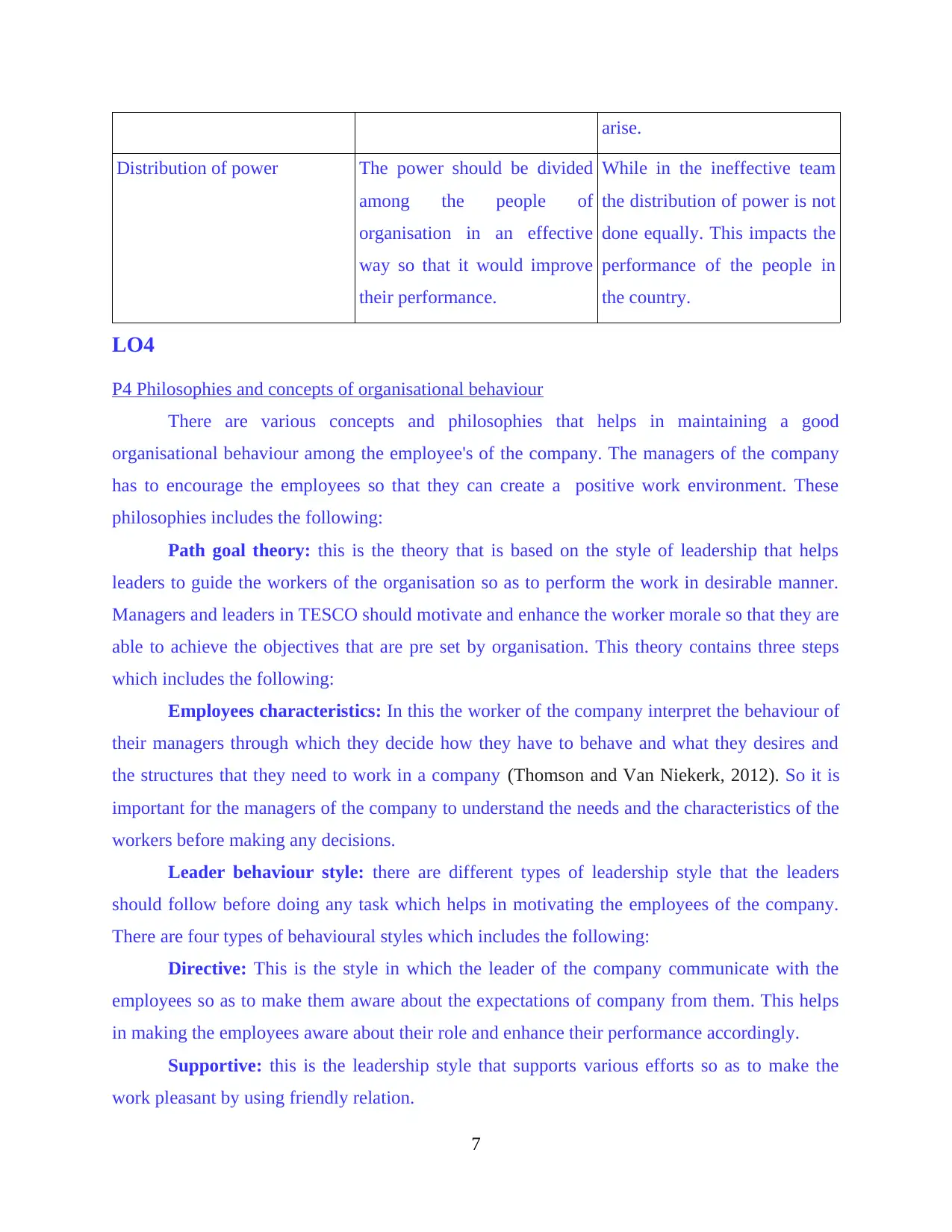
arise.
Distribution of power The power should be divided
among the people of
organisation in an effective
way so that it would improve
their performance.
While in the ineffective team
the distribution of power is not
done equally. This impacts the
performance of the people in
the country.
LO4
P4 Philosophies and concepts of organisational behaviour
There are various concepts and philosophies that helps in maintaining a good
organisational behaviour among the employee's of the company. The managers of the company
has to encourage the employees so that they can create a positive work environment. These
philosophies includes the following:
Path goal theory: this is the theory that is based on the style of leadership that helps
leaders to guide the workers of the organisation so as to perform the work in desirable manner.
Managers and leaders in TESCO should motivate and enhance the worker morale so that they are
able to achieve the objectives that are pre set by organisation. This theory contains three steps
which includes the following:
Employees characteristics: In this the worker of the company interpret the behaviour of
their managers through which they decide how they have to behave and what they desires and
the structures that they need to work in a company (Thomson and Van Niekerk, 2012). So it is
important for the managers of the company to understand the needs and the characteristics of the
workers before making any decisions.
Leader behaviour style: there are different types of leadership style that the leaders
should follow before doing any task which helps in motivating the employees of the company.
There are four types of behavioural styles which includes the following:
Directive: This is the style in which the leader of the company communicate with the
employees so as to make them aware about the expectations of company from them. This helps
in making the employees aware about their role and enhance their performance accordingly.
Supportive: this is the leadership style that supports various efforts so as to make the
work pleasant by using friendly relation.
7
Distribution of power The power should be divided
among the people of
organisation in an effective
way so that it would improve
their performance.
While in the ineffective team
the distribution of power is not
done equally. This impacts the
performance of the people in
the country.
LO4
P4 Philosophies and concepts of organisational behaviour
There are various concepts and philosophies that helps in maintaining a good
organisational behaviour among the employee's of the company. The managers of the company
has to encourage the employees so that they can create a positive work environment. These
philosophies includes the following:
Path goal theory: this is the theory that is based on the style of leadership that helps
leaders to guide the workers of the organisation so as to perform the work in desirable manner.
Managers and leaders in TESCO should motivate and enhance the worker morale so that they are
able to achieve the objectives that are pre set by organisation. This theory contains three steps
which includes the following:
Employees characteristics: In this the worker of the company interpret the behaviour of
their managers through which they decide how they have to behave and what they desires and
the structures that they need to work in a company (Thomson and Van Niekerk, 2012). So it is
important for the managers of the company to understand the needs and the characteristics of the
workers before making any decisions.
Leader behaviour style: there are different types of leadership style that the leaders
should follow before doing any task which helps in motivating the employees of the company.
There are four types of behavioural styles which includes the following:
Directive: This is the style in which the leader of the company communicate with the
employees so as to make them aware about the expectations of company from them. This helps
in making the employees aware about their role and enhance their performance accordingly.
Supportive: this is the leadership style that supports various efforts so as to make the
work pleasant by using friendly relation.
7
Paraphrase This Document
Need a fresh take? Get an instant paraphrase of this document with our AI Paraphraser
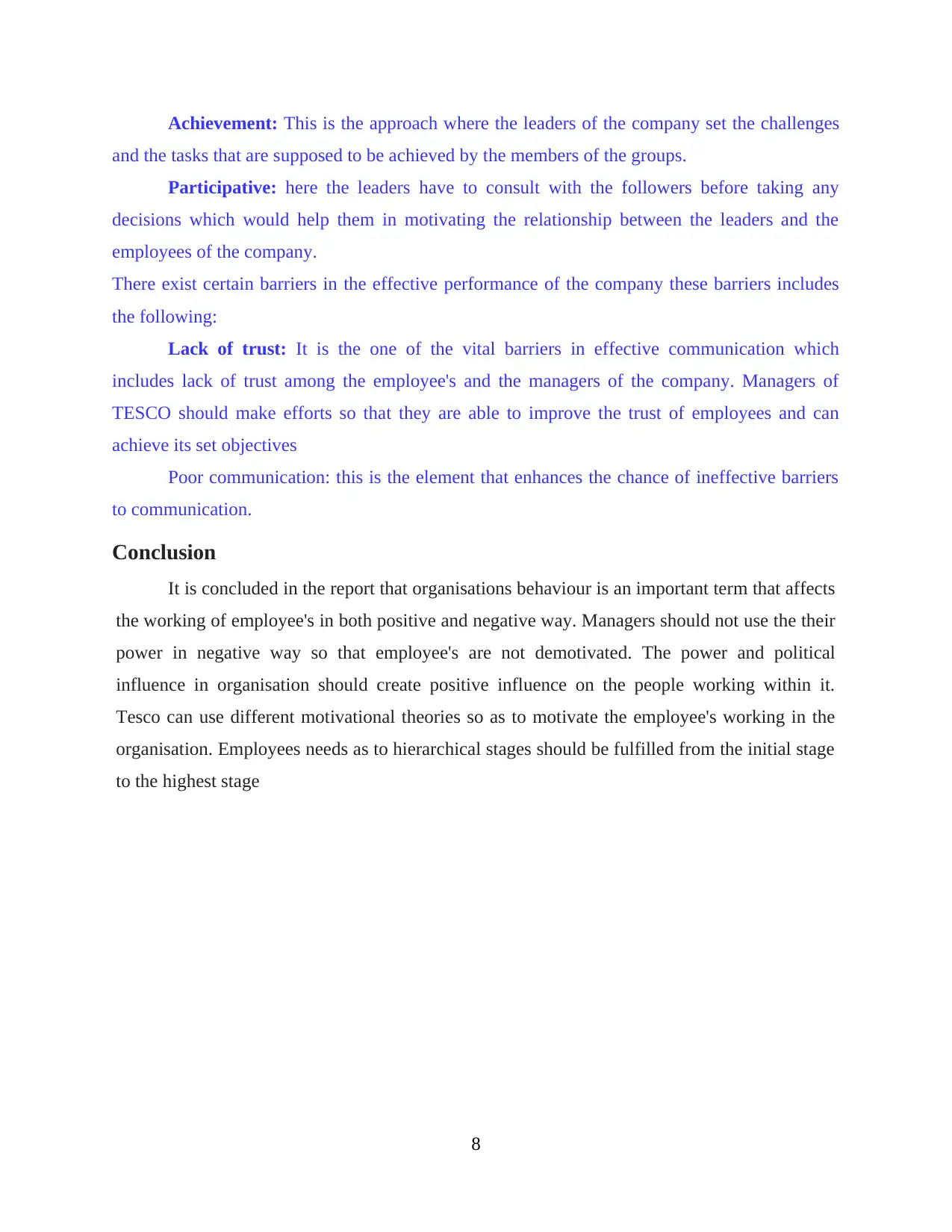
Achievement: This is the approach where the leaders of the company set the challenges
and the tasks that are supposed to be achieved by the members of the groups.
Participative: here the leaders have to consult with the followers before taking any
decisions which would help them in motivating the relationship between the leaders and the
employees of the company.
There exist certain barriers in the effective performance of the company these barriers includes
the following:
Lack of trust: It is the one of the vital barriers in effective communication which
includes lack of trust among the employee's and the managers of the company. Managers of
TESCO should make efforts so that they are able to improve the trust of employees and can
achieve its set objectives
Poor communication: this is the element that enhances the chance of ineffective barriers
to communication.
Conclusion
It is concluded in the report that organisations behaviour is an important term that affects
the working of employee's in both positive and negative way. Managers should not use the their
power in negative way so that employee's are not demotivated. The power and political
influence in organisation should create positive influence on the people working within it.
Tesco can use different motivational theories so as to motivate the employee's working in the
organisation. Employees needs as to hierarchical stages should be fulfilled from the initial stage
to the highest stage
8
and the tasks that are supposed to be achieved by the members of the groups.
Participative: here the leaders have to consult with the followers before taking any
decisions which would help them in motivating the relationship between the leaders and the
employees of the company.
There exist certain barriers in the effective performance of the company these barriers includes
the following:
Lack of trust: It is the one of the vital barriers in effective communication which
includes lack of trust among the employee's and the managers of the company. Managers of
TESCO should make efforts so that they are able to improve the trust of employees and can
achieve its set objectives
Poor communication: this is the element that enhances the chance of ineffective barriers
to communication.
Conclusion
It is concluded in the report that organisations behaviour is an important term that affects
the working of employee's in both positive and negative way. Managers should not use the their
power in negative way so that employee's are not demotivated. The power and political
influence in organisation should create positive influence on the people working within it.
Tesco can use different motivational theories so as to motivate the employee's working in the
organisation. Employees needs as to hierarchical stages should be fulfilled from the initial stage
to the highest stage
8
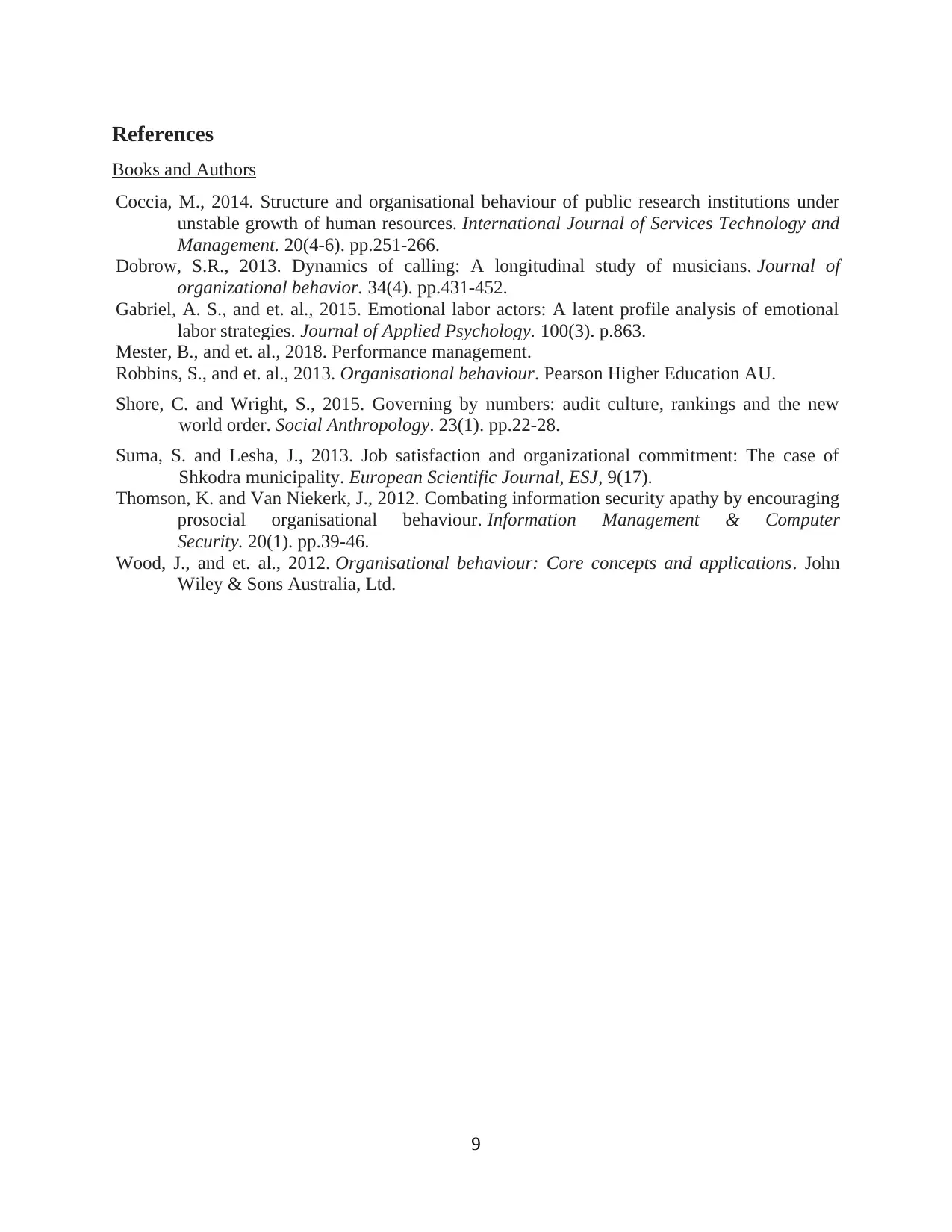
References
Books and Authors
Coccia, M., 2014. Structure and organisational behaviour of public research institutions under
unstable growth of human resources. International Journal of Services Technology and
Management. 20(4-6). pp.251-266.
Dobrow, S.R., 2013. Dynamics of calling: A longitudinal study of musicians. Journal of
organizational behavior. 34(4). pp.431-452.
Gabriel, A. S., and et. al., 2015. Emotional labor actors: A latent profile analysis of emotional
labor strategies. Journal of Applied Psychology. 100(3). p.863.
Mester, B., and et. al., 2018. Performance management.
Robbins, S., and et. al., 2013. Organisational behaviour. Pearson Higher Education AU.
Shore, C. and Wright, S., 2015. Governing by numbers: audit culture, rankings and the new
world order. Social Anthropology. 23(1). pp.22-28.
Suma, S. and Lesha, J., 2013. Job satisfaction and organizational commitment: The case of
Shkodra municipality. European Scientific Journal, ESJ, 9(17).
Thomson, K. and Van Niekerk, J., 2012. Combating information security apathy by encouraging
prosocial organisational behaviour. Information Management & Computer
Security. 20(1). pp.39-46.
Wood, J., and et. al., 2012. Organisational behaviour: Core concepts and applications. John
Wiley & Sons Australia, Ltd.
9
Books and Authors
Coccia, M., 2014. Structure and organisational behaviour of public research institutions under
unstable growth of human resources. International Journal of Services Technology and
Management. 20(4-6). pp.251-266.
Dobrow, S.R., 2013. Dynamics of calling: A longitudinal study of musicians. Journal of
organizational behavior. 34(4). pp.431-452.
Gabriel, A. S., and et. al., 2015. Emotional labor actors: A latent profile analysis of emotional
labor strategies. Journal of Applied Psychology. 100(3). p.863.
Mester, B., and et. al., 2018. Performance management.
Robbins, S., and et. al., 2013. Organisational behaviour. Pearson Higher Education AU.
Shore, C. and Wright, S., 2015. Governing by numbers: audit culture, rankings and the new
world order. Social Anthropology. 23(1). pp.22-28.
Suma, S. and Lesha, J., 2013. Job satisfaction and organizational commitment: The case of
Shkodra municipality. European Scientific Journal, ESJ, 9(17).
Thomson, K. and Van Niekerk, J., 2012. Combating information security apathy by encouraging
prosocial organisational behaviour. Information Management & Computer
Security. 20(1). pp.39-46.
Wood, J., and et. al., 2012. Organisational behaviour: Core concepts and applications. John
Wiley & Sons Australia, Ltd.
9
⊘ This is a preview!⊘
Do you want full access?
Subscribe today to unlock all pages.

Trusted by 1+ million students worldwide
1 out of 12
Related Documents
Your All-in-One AI-Powered Toolkit for Academic Success.
+13062052269
info@desklib.com
Available 24*7 on WhatsApp / Email
![[object Object]](/_next/static/media/star-bottom.7253800d.svg)
Unlock your academic potential
Copyright © 2020–2025 A2Z Services. All Rights Reserved. Developed and managed by ZUCOL.





